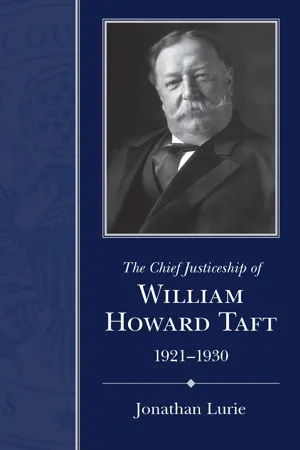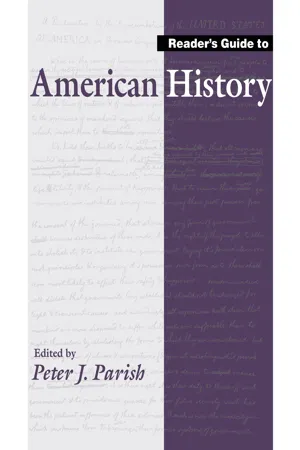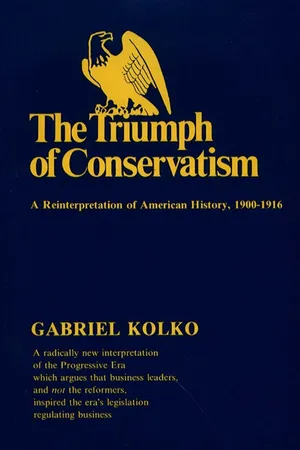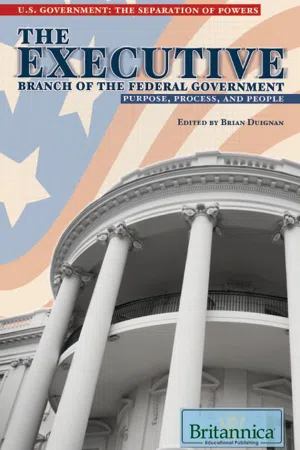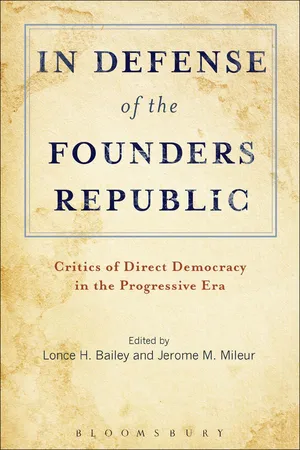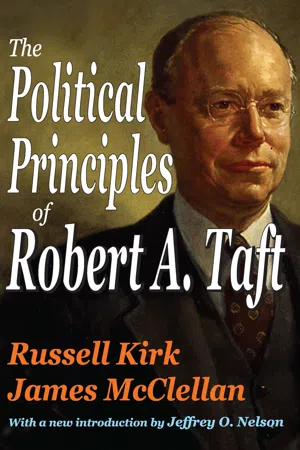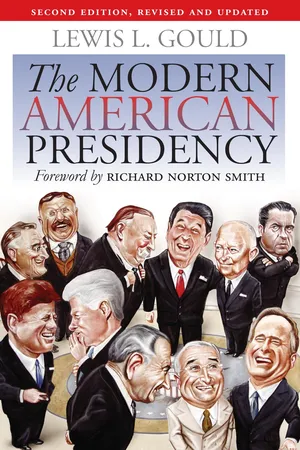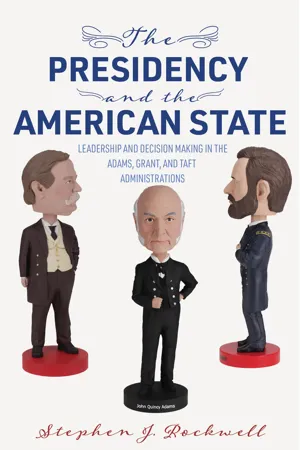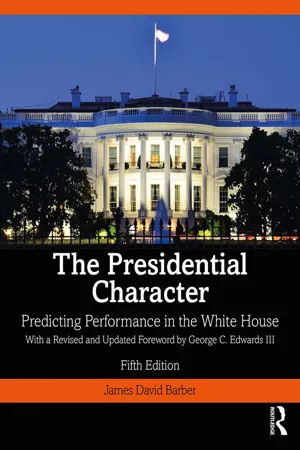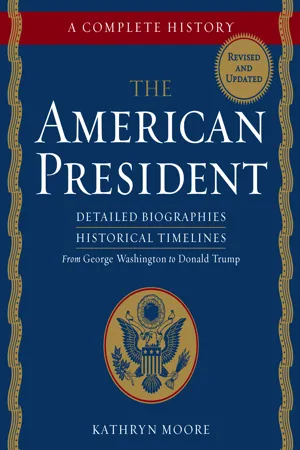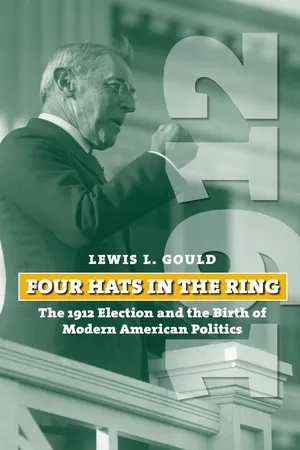History
William Howard Taft
William Howard Taft was the 27th President of the United States, serving from 1909 to 1913. He was also the 10th Chief Justice of the United States, from 1921 to 1930, making him the only person to have held both offices. Taft is known for his efforts to promote world peace and for his commitment to trust-busting and reforming the civil service.
Written by Perlego with AI-assistance
Related key terms
Related key terms
1 of 4
Related key terms
1 of 3
12 Key excerpts on "William Howard Taft"
- Jonathan Lurie(Author)
- 2019(Publication Date)
- University of South Carolina Press(Publisher)
1TAFT AND HIS COURT IN 1921The Cast of Players1IN ITS ENTIRE HISTORY no member of the United States Supreme Court has brought to the bench the unique perspective and experience of William Howard Taft. To be sure, before and since his appointment, no man has ever served as both president and Supreme Court justice—let alone chief justice. Indeed only two former presidents have ever returned to federal office: John Quincy Adams to the House of Representatives, and Andrew Johnson to the U.S. Senate. When compared with Chief Justices John Marshall and Roger Taney, who between them served for about sixty years, William Howard Taft’s tenure as chief justice was relatively brief—barely eight years.1 But for that period of time, Taft brought an incredible resume to this office.2His life (1857 to 1930) began on the eve of the Civil War. He matured at the height of the Gilded Age, and he was one of the youngest solicitor generals in the history of the Justice Department. He witnessed the transformation and travails of urban America, the violence between labor and capital, the triumph of American industrialism, the new concepts of law as a science, the emergence of the United States as a world power, the rise and fall of populism, the Progressive Era, the Spanish-American War and America’s introduction to imperialism, World War I and its tragic denouement concerning the ill-fated League of Nations, and finally the Roaring Twenties.Taft did more than just observe these developments. They formed the background for a career in which he held an unusual variety of positions, virtually all of them appointed. As a young superior court judge in Cincinnati, he rendered decisions on a variety of legal issues. As the U.S. solicitor general, he regularly appeared before the Supreme Court between 1889 and 1892 and won the great majority (sixteen out of eighteen) of the cases in which he argued. As a judge in the newly created U.S. Circuit Court of Appeals, Taft left his mark on the law especially in the fields of labor relations and industrial regulation, and as the president of the commission to govern the Philippines, he saw for himself what American adventures on the imperialistic stage might ultimately cost. His seemingly firm friendship with Theodore Roosevelt began in the 1880s and ripened to a point where as president TR not only offered Taft an appointment to the high court on at least two different occasions but also made him his secretary of war. In 1908 at TR’s urging Taft sought and won the Republican presidential nomination and succeeded TR as president. Their friendship shattered during his term, and in 1912 TR insisted on running against the man he had selected as his successor, ensuring defeat for them both by Woodrow Wilson. Upon leaving office Taft became a professor of law at Yale, his old alma mater (he declined to be a candidate for its presidency). In 1921 he was appointed chief justice of the United States by President Warren Harding.- eBook - ePub
- Peter J. Parish(Author)
- 2013(Publication Date)
- Routledge(Publisher)
T
27th President of the United States, and Chief Justice of the Supreme CourtTaft, William Howard 1857–1930Anderson, Donald F., William Howard Taft: A Conservative's Conception of the Presidency , Ithaca, NY: Cornell University Press, 1973Anderson, Judith Icke, William Howard Taft: An Intimate History , New York: Norton, 1981Coletta, Paolo E., The Presidency of William Howard Taft , Lawrence: University Press of Kansas, 1973Duffy, Herbert S., William Howard Taft , New York: Minton Balch, 1930Manners, William, TR and Will: A Friendship That Split the Republican Party , New York: Harcourt Brace, 1969Mason, Alpheus T., William Howard Taft: Chief Justice , New York: Simon and Schuster, and London: Oldbourne, 1965Minger, Ralph Eldon, William Howard Taft and United States Foreign Policy: The Apprenticeship Years, 1900–1908 , Urbana: University of Illinois Press, 1975Pringle, Henry R, The Life and Times of William Howard Taft , 2 vols., New York: Farrar and Rinehart, 1939Ross, Ishbel, An American Family: The Tafts, 1678 to 1964 , Cleveland: World, 1964Scholes, Walter and Marie V. Scholes, The Foreign Policies of the Taft Administration , Columbia: University of Missouri Press, 1970Vivian, James F. (editor), William Howard Taft: Collected Editorials, 1917–1921 , New York: Praeger, 1990Wedged between the strong presidencies of Theodore Roosevelt and Woodrow Wilson, William Howard Taft has usually been depicted as a failure in office because of his inability to emulate the success of Roosevelt as a champion of reform and to achieve re-election in 1912. The scope of his presidential papers has also inhibited serious scholarship about his years in office. The best biography is almost sixty years old, and there is no thorough study of his years in the White House.DUFFY was a biography that came out in the year of Taft's death. It was not a serious work of historical inquiry, and was superseded within a decade by PRINGLE. A distinguished biographer of Theodore Roosevelt, Pringle received full access to the Taft Papers. He produced a very sympathetic biography that made a strong case for Taft's competence as president, defended his role in the feud with Roosevelt, and rehabilitated Taft in such episodes as the Ballinger-Pinchot controversy over conservation policy. Pringle was quickly recognized as the standard life of President Taft, though his interpretive insights did not change the existing historical interpretation of Taft as a mediocre president. - eBook - ePub
- Gabriel Kolko(Author)
- 2008(Publication Date)
- Free Press(Publisher)
THE ORDEAL OF William Howard Taft, 1909-1911The Legacy of Reform
William Howard Taft inherited an ambiguous legacy from the Administration of Theodore Roosevelt. And, given the deeper ambiguities in the very nature of progressivism, as well as in the new President’s own values, his leadership was to be marred by innumerable contradictions and seeming inconsistencies. Had his wife been less ambitious, the new President would have preferred a quiet, predictable chief justiceship on the Supreme Court. But at the beginning of 1909 Taft was still the anointed successor to Roosevelt, elected with the support of big business during the furious campaign against William Jennings Bryan, and as yet untried in the uncharted seas of national politics.Taft, of course, had campaigned on the record of Roosevelt, and endorsed the record as he understood it. Roosevelt’s legacy is clear to the modern historian, but it was less so to the contemporary observer as well as to Taft. Roosevelt was known as the “trustbuster” despite the fact that he busted very few trusts. Many disliked his tone, and confused his critical verbiage in regard to the Harrimans and Rockefellers with a genuine enthusiasm for reform. Roosevelt had embarked on a campaign to save business both from its own folly and from the dangers the unthinking masses posed in a formal political democracy potentially capable of really operating as a democracy. Despite the rhetoric of serving as the President for the entire nation, Roosevelt felt naturally comfortable only in the company of Knox, Lodge, Aldrich, Root and other members of the Eastern social and business elite. He considered himself, quite appropriately, a conservative trying to avoid revolutionary chaos by bringing the industrial structure under reasonable control. He repeatedly accepted the inevitability of corporate concentration as the basis for any measure of control. By a series of détentes and administrative decisions, and by ignoring the vague Sherman Act, Roosevelt was able to create a rather arbitrary political capitalism dependent more on his personal whims than on any formally rationalized system. In virtually every area in which he acted, however, he responded to initiatives shown by others in formulating basic proposals. His major legislative measures reflected the desires and pressures of specific interests, and his détentes with corporations were invariably the result of their initiatives. - eBook - ePub
The Executive Branch of the Federal Government
Purpose, Process, and People
- Britannica Educational Publishing, Brian Duignan(Authors)
- 2009(Publication Date)
- Britannica Educational Publishing(Publisher)
Although he had some slight hope for the 1916 Republican nomination, Roosevelt was ready to support almost any candidate who opposed Wilson; he abandoned the Progressives to support the Republican candidate, Charles Evans Hughes, who lost by a narrow margin. After the United States entered World War I, his anger at Wilson boiled over when his offer to lead a division to France was rejected. By 1918 Roosevelt’s support of the war and his harsh attacks on Wilson reconciled Republican conservatives to him, and he was the odds-on favourite for the 1920 nomination. But he died in early January 1919, less than three months after his 60th birthday.William Howard Taft
(b. Sept. 15, 1857, Cincinnati, Ohio—d. March 8, 1930, Washington, D.C.)W illiam Howard Taft was the 27th president of the United States (1909–13) and the 10th chief justice of the United States (1921–30). As the choice of Pres. Theodore Roosevelt to succeed him and carry on the progressive Republican agenda, Taft as president alienated the progressives—and later Roosevelt—thereby contributing greatly to the split in Republican ranks in 1912, to the formation of the Bull Moose Party, and to his humiliating defeat that year in his bid for a second term.The son of Alphonso Taft, secretary of war and attorney general (1876–77) under Pres. Ulysses S. Grant, and Louisa Maria Torrey, Taft graduated second in his Yale class of 1878, studied law, and was admitted to the Ohio bar in 1880. Drawn to politics in the Republican Party, he served in several minor appointive offices until 1887, when he was named to fill the unfinished term of a judge of the superior court of Ohio. The following year he was elected to a five-year term of his own, the only time he ever attained office via popular vote other than his election to the presidency. From 1892 to 1900 he served as a judge of the United States Sixth Circuit Court of Appeals, where he made several decisions hostile to organized labour.In 1901 Taft became the first civilian governor of the Philippines, concentrating in that post on the economic development of the islands. In 1904 he agreed to return to Washington to serve as Theodore Roosevelt’s secretary of war, with the stipulation that he could continue to supervise Philippine affairs. - eBook - ePub
In Defense of the Founders Republic
Critics of Direct Democracy in the Progressive Era
- Lonce H. Bailey, Jerome M. Mileur(Authors)
- 2015(Publication Date)
- Bloomsbury Academic(Publisher)
5 William Howard Taft: The Constitutionalist as Critic of Progressivism Paul M. Rego Messiah CollegeWilliam Howard Taft was dedicated to the law and devoted his life to it. He was, in fact, more cut out to be a lawyer, a judge, and an administrator than a politician.1 By nearly all accounts, the political side of the presidency—the cultivation of public opinion and the press, as well as legislative leadership—did not seem to interest him, and he was not particularly good at any of it.2 As president, Theodore Olson observes, Taft lacked “charisma, innovator’s impulse, fighter’s mentality, concern for his public reputation, and political savvy to function as an effective leader in the greatest of political arenas.” In light of these political deficiencies, it is not surprising that Taft wrote to his wife, Nellie: “Politics, when I am in it, makes me sick.”3The law had consumed most of Taft’s prepresidential life. After graduating from Yale, he went to law school and opened a private practice in Ohio. By the time he was thirty-two, Taft had been an assistant prosecutor and a superior court judge in Ohio. In 1890, President Benjamin Harrison appointed Taft to be the Solicitor General of the United States. Two years later, he became a federal appellate judge but resigned this position when asked by President William McKinley to head a commission to establish civil government in the Philippines. He ultimately served as the first civil governor of the Philippines. In 1904, President Theodore Roosevelt made Taft Secretary of War, and by 1908, TR had decided that Taft should succeed him as president. Over the previous four years, Roosevelt and Taft had become friends, and Taft had been a staunch defender of Roosevelt and his policies. But, if Taft tended to sympathize with the aims of Progressives like Roosevelt, he was increasingly concerned about their approach. In the end, a majority of Progressives, including Roosevelt, abandoned him and his presidency.4 - eBook - ePub
- Russell Kirk(Author)
- 2017(Publication Date)
- Routledge(Publisher)
Like Edmund Burke, Robert Taft examined the foundations of society only with reluctance. A man of law, and not of metaphysics, he accepted American society as fundamentally sound; and his guiding principle was the rule of law. The federal Constitution, the legal institutions of America, and the traditions of the civil social order were the living rock upon which his convictions were founded. It was his labor to defend, and prudently to improve piecemeal, the American political and economic structure into which he had been born, and in the goodness of which he thoroughly believed. He stood as a practitioner of what has been called the “Great Tradition” of politics, maintaining justice through a healthy tension of order and freedom; so far as one may refer to a philosophical or a religious sanction for his beliefs, it was that complex of Christian and classical concepts of a moral order, right and duty, charity and justice. (Taft himself, it may be remarked, did not think of his own convictions as a “system.”) As Tocqueville observed, the United States of America is governed for the most part by a kind of institutional aristocracy of lawyers, schooled in precedent and due process. Robert Taft was an eminent member of that body of republican governors.In political opposition until the last six months of his life, Taft never took any executive office, and so is more important as a critic than as an architect of national policy. Several important legislative measures, nevertheless, were his work—most notably the Taft-Hartley Act governing labor-management relationships, and his part in the enactment of the first post-war federal public-housing measure. In terms of industry and practical intelligence, he was perhaps the ablest senator of this century; in influence over his party (for all that he never received its presidential nomination) and over public opinion generally, he was a man of power. Had he not been a man of high principle, his power might have been greater still. As an exemplar of American political rectitude and ability, he deserves to be remembered.Yet for the crowd, Taft had no charisma. There was in him nothing of Theodore Roosevelt’s magnetism, or of Franklin Roosevelt’s beguiling public charm. His own father’s wit and humor were not Robert Taft’s—not in public. Most of the time, Taft seemed to the crowd a stiff and sober figure—benign, perhaps, but not constituted to warm one’s heart. He could win Ohio elections thumpingly; still, like the Venetian Glass Nephew, he did not know how to play. The demagogue’s arts were not his, nor the heroic attitudes of the Periclean master of men. “Taft has been called a poor politician,” a friendly observer wrote. “In a conventional sense, he is. He not only lacks glamor, he scorns it—’there is so little underneath it.’”1 - eBook - ePub
The Modern American Presidency
Second Edition, Revised and Updated
- Lewis L. Gould(Author)
- 2009(Publication Date)
- University Press of Kansas(Publisher)
2The Lawyer and the Professor William Howard Taft and Woodrow WilsonIn the evolution of the modern presidency, Woodrow Wilson receives an honored place as an exponent of strong leadership during his two terms. Fighting a war to victory caused Wilson to strengthen the scope and authority of his office. For William Howard Taft and his single term from 1909 to 1913, the appraisal is more mixed. Taking office after Theodore Roosevelt and serving only one troubled term, Taft is usually seen as more in the mold of Warren G. Harding and Calvin Coolidge, other Republican presidents who fell short of greatness in office. Yet both Taft and Wilson also shaped their presidencies in reaction to Theodore Roosevelt’s example. In so doing, they developed practices that extended the creation of the modern presidency.Both Taft and Wilson found themselves conducting the presidency as the system of partisan politics that had been dominant in the late nineteenth century experienced further declines. At the same time, the emerging mass media influenced how presidential news was covered and the presidency interpreted. Taft never mastered these changing elements. Wilson had some success during his first term but found his second administration more problematic. By the time he gave way to Warren G. Harding in March 1921, Wilson’s presidential leadership had been repudiated by the American people.The procedural reforms of the Progressive Era gathered momentum during these two administrations, and the net result was a tangible decline in the shaping role of parties in political affairs. During the Taft years, the direct election of U.S. Senators was achieved through a constitutional amendment. Woman suffrage became a stronger national campaign, as state after state adopted some form of it, and the advocates of national change pressed for their constitutional amendment. In choosing presidential candidates, the direct primary became more common, and the changes embodied in the initiative, referendum, and recall also appeared in some states. Popular sentiment against parties intensified. As one progressive put it in 1910, “The people are inclined to be suspicious of any partisan organization. It suggests exclusiveness, possibly some sinister purpose and at least the chaining of big men to little or corrupt men. There is a loss of moral force in party action.”1 - eBook - ePub
Miller Center Studies on the Presidency
Leadership and Decision Making in the Adams, Grant, and Taft Administrations
- Stephen J. Rockwell(Author)
- 2023(Publication Date)
- University of Virginia Press(Publisher)
53Taft seeded his administration with people who were competent, experienced experts dedicated as much to Taft’s understanding of the importance of procedural fairness and the rule of law as they were to Taft’s progressive conservatism. He embraced the future, buying automobiles for the presidency, promoting the industry, and happily chugging about DC in experimental steam- and gasoline-powered cars after years in which Roosevelt had remained loyal to the horse.54 Taft modernized the presidency, working to enshrine innovative approaches to national budgeting and administration in clearly defined rules and procedures.55President Taft and the Progressive State
Taft’s major policy accomplishments and initiatives—among them conservation; international arbitration treaties; and reforms encompassing the tariff, taxation, and campaign finance—are addressed in detail in the next chapter. But that list is augmented by a variety of little-known or long-forgotten efforts by Taft to use his administration’s experts, executive tools, and legislative actions to build new and enduring programs and processes, and to protect core institutions of republican governance. In a tense era, facing a fragmented Congress and a fractured Republican Party, President Taft laid out a host of initiatives including worker protections and postal savings banks, he influenced governance reform in Puerto Rico, and he worked to protect the independence of the judiciary.56 Taft’s approach to synthesizing law and principle never overlooked the human connections endemic to successful politics. He was driven by basic priorities: peace over war; restraint over aggression; cooperation over dominance. “The ultimate purpose of government and its limitations must be conceded to be the same,” Taft wrote, “the promotion of the happiness of the average individual and his progress.”57 - eBook - ePub
The Presidential Character
Predicting Performance in the White House, With a Revised and Updated Foreword by George C. Edwards III
- James Barber(Author)
- 2019(Publication Date)
- Routledge(Publisher)
Taft had opinions on the big issues of his time—on the tariff, conservation, labor, and so on—but his political world view was, with one exception, amorphous and uncertain. He was a conservative progressive, but above all he was a law-lover. His mother told the press when Taft was being boomed for the Presidency, "I do not want my son to be President; he is not my candidate. His is a judicial mind, and he loves the law." Insofar as Taft had a philosophy it was this: "We have a government of limited power under the Constitution and we have got to work out our problems on the basis of law." As President he was an ardent believer in the judicial settlement of international disputes. Later, as Chief Justice, Taft felt that the Court, "next to my wife and children, is the nearest thing to my heart in life." "The truth is that in my present life I don't remember that I ever was President," he wrote. Pringle points out the depth and difficulty of Taft's legal enthusiasm:Taft worshipped the law; no understanding of him is possible without appreciation of that fact. The fallacy in his philosophy lies, of course, in the fact that there is no such thing as "the law." It is a mass of opinion, formulated by men throughout the centuries, and is constantly being altered. What Taft really did was to revere the law, as he understood it, himself, or as judges with whom he agreed interpreted it.2Taft was attracted to Theodore Roosevelt for many reasons, one of the strongest of which was that TR stood in Taft's mind as defender of the laws—of "the guaranties of the Constitution ... in favor of life, liberty and property"—against the "illegal ways," the "methods contrary to statute law," of profiteers who thought it "fashionable and conventional to ignore the existence of the statutes of the United States." Before he was President, Taft saw the essential quality of Roosevelt's progressivism in the proposition that "the guaranty with respect to the right of property would be undermined by a movement toward socialism," in the observation that "this movement has gained force by the use of accumulated wealth and power in illegal ways and by duress to suppress competition and center financial control in a few hands . . . contrary to statute law," and in the inference that it was necessary to enforce those laws, even if that meant taking "the great corporations by the throat" and putting "the fear of God into the hearts of their managers." In those respects, Taft claimed, "Mr. Roosevelt's views were mine long before I knew Mr. Roosevelt at all." - eBook - ePub
Star-Spangled Men
America's Ten Worst Presidents
- Nathan Miller(Author)
- 2008(Publication Date)
- Scribner(Publisher)
William Howard TaftO ne evening in January 1908, Theodore Roosevelt invited his good friend Secretary of War William Howard Taft and his wife, Nellie, to the White House. Following dinner, the president leaned back in a leather chair, closed his eyes, and pretending to be in a trance, intoned, “I am the seventh son of a seventh daughter. I have clairvoyant powers. I see a man before me weighing three hundred and fifty pounds. There is something hanging over his head. I cannot make out what it is; it is hanging by a slender thread. At one time it looks like the presidency—then again it looks like the chief justiceship.”“Make it the chief justiceship,” said Taft.“Make it the presidency!” cried the ambitious Nellie.1The question of a successor dominated Roosevelt’s last two years in office. He came to power in September 1901 following the assassination of President William McKinley and, upon election to the presidency in his own right three years later, had announced that he would not be a candidate for reelection in 1908. Whom would he anoint in his place? Perhaps it would be Elihu Root, who had served him ably as secretary of war and state? Would it be Governor Charles Evans Hughes of New York, who had recently been propelled into the limelight by an investigation of the insurance industry? Or would it be Taft? Unhappily for Roosevelt, Will Taft, and the nation, Nellie Taft got her wish.Corpulent, lethargic, and slow-moving, Taft projected an aura of fumble, bumble, and stumble. He was the wrong man in the wrong place at the wrong time. The temper of the times was progressive; he was conservative. The nation wanted an activist president; he was the champion of the status quo. Any man who enters the presidency as the leader of a party that controls the White House and Congress and with overwhelming public support and then fritters away his mandate and popularity, barely carrying only two states four years later, certainly belongs on any list of worst presidents. Time has cast a veil over Taft’s ineptness, and some writers have tried to rehabilitate him because he was an amiable and even pathetic figure, but the facts speak for themselves. - eBook - ePub
The American President
A Complete History
- Kathryn Moore, Kathryn Moore(Authors)
- 2018(Publication Date)
- Union Square & Co.(Publisher)
4 Within a year, Taft won the election to keep his judgeship.While many of Taft’s decisions were routine in nature, one case would be used against him in later years. In Moores & Co. v. Bricklayers’ Union , he and his fellow judges found that the union had been guilty of conspiring against another company because the company had refused to hire certain bricklayers. When the union refused to work, the supply companies were affected, including the business, Moores & Co., a lime manufacturer. The original trial had found in favor of the plaintiff and awarded them $2,250 in damages. Taft and his colleagues upheld the verdict, later leading to cries of anti-union, anti-labor from Democrats.Taft was pleased to be a judge, but still yearned to be a justice on the US Supreme Court and attempted to push his name with President Benjamin Harrison when a vacancy occurred. Again, Governor Foraker backed him, but this time, Taft’s youth and judicial inexperience hindered him and he was refused. As a consolation prize, however, Harrison offered him the post of solicitor general, which Taft accepted.On Valentine’s Day, 1890, Taft was sworn in to his new position. Nellie remained in Cincinnati with their six-month-old son Robert while Taft secured appropriate lodging. In Washington, the Tafts met another young couple, Theodore and Edith Roosevelt. The men hit it off, but the women never became friends. Theodore was serving on the Civil Service Commission, and Will was attracted to the human dynamo. Meanwhile, Taft was hard at work, aiding the attorney general, but he still found serving in a judicial capacity more rewarding. Nellie, however, urged him to become more involved in politics; thus, Taft came to a crossroads in 1892, and took the path more to his liking, securing an appointment to the US Sixth Circuit Court and its Court of Appeals. He was just as pleased that he and his family, which now included baby daughter Helen, could return home to Cincinnati. - eBook - ePub
Four Hats in the Ring
The 1912 Election and the Birth of Modern American Politics
- Lewis L. Gould(Author)
- 2017(Publication Date)
- University Press of Kansas(Publisher)
Believing that his presidential role was to be a party leader who maintained GOP unity and helped enact their legislative program, Taft stressed working with the Republican establishment in Congress. Once he became identified with Nelson Aldrich, the dominant Republican in the Senate, and Joseph G. Cannon, the autocratic Speaker of the House, Taft raised suspicions among party reformers and friends of Roosevelt. In turn, the president resented opposition to his policies. He moved rightward toward his natural allies among Republican conservatives.The nation over which William Howard Taft presided in March 1909 was in the midst of the period that historians have dubbed the Progressive Era. Since the end of the depression of the 1890s, the United States had experienced an age of political and social reform. In a series of campaigns to improve the quality of life, activists had sought an enhanced role for government at all levels in regulating business, supervising morality, and purifying the political system. Within the general consensus that the United States was a nation that God favored to set an example for the world, progressives, as they called themselves, argued that people were basically good. The right application of government support could make them even better.Since the accession of Theodore Roosevelt to the presidency in September 1901, the impulse for reform had grown stronger. Roosevelt had placed his intense personality behind the idea that a more just society would prevent a social revolution and class warfare. Many middle-class Americans responded to this call. The reform elements within the Democratic Party, too, applauded parts of Roosevelt’s program and contended that even more regulation of business was necessary. The election of 1912 would be waged largely on domestic issues growing out of these concerns.Unlike the 1890s, when hard times determined political responses, the political struggles leading up to 1912 occurred during an era of general economic prosperity. Since the presidency of William McKinley, economic indicators had much improved. The gross national product, which stood at an annual average of $17.3 billion between 1897 and 1901, would rise to $40.3 billion from 1912 to 1916. The average wage earner among the 95 million Americans brought in $592 per year in 1912, up from $454 in 1901. For that sum, the same individual worked fifty-six hours each week for a little more than 27 cents an hour. Ten years before, a comparable worker would have labored 58.7 hours weekly for 22 cents per hour. In that respect, the economy during the first decade of the twentieth century had produced real gains for most Americans.
Index pages curate the most relevant extracts from our library of academic textbooks. They’ve been created using an in-house natural language model (NLM), each adding context and meaning to key research topics.
Explore more topic indexes
Explore more topic indexes
1 of 6
Explore more topic indexes
1 of 4
